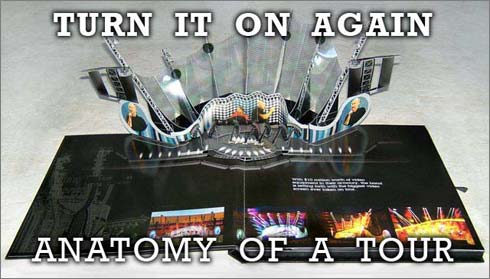

 The Anatomy Of A Book
The Anatomy Of A Book A sumptuous book in a large format. It is almost square (29x28cm), in smooth black paper binding and almost as thick as a thumb. There is a little loop at the side. We will get to that.
When you open the book an origami version of the European stadium stage unfolds. Colourful cardboard and plastic give an impression of the dimensions and the colour design of the stage, the lighting towers, nets and the LED screen wave. It is supplemented by screenshots of computer animations of the stage that show different uses of light and special effects. Here as everywhere things are printed on glossy black paper that really lets the images shine. Another recurring design element are silver grey CAD models of the stage.
Turning over to the next page closes the European stadium stage and another 3D model unfolds. It is the stage for the indoor shows on the North American tour. The model is accompanied by a selection of lightshow simulations and parts of the CAD model.
Now it is time for the loop. Many things can be done with it. Pulling on it proves a good idea because it is attached to a kind of tray in which lies a slightly smaller book, The Anatomy Of A Tour proper.
Remarkably detailed CAD models of the stage accompany us through the book. Photos of stages of yore (1977 to 1992, to be precise) illustrate just how varied and creative Genesis stages always have been. Mark Fisher and Patrick Woodroffe sketch in brief comments how they arrived at the particular stage design and also mention the problems that arose. They explain how the use light effects to direct the audience’s eyes both towards the main stage and outside and upwards. The immense technical effort goes not unnoticed either. Finally they also write a bit about the arena stage.
The comments are quite brief, and the reviewer would have wished for some more details, e.g. why is the stage backdrop curved? After all, one consequence of this shape is the problem that fans to the immediate left and right of the stage cannot see it to full extent. The book remains silent on this issue, and perhaps it has to be because the images are more captivating than the texts. The illustrations are very charming throughout. CAD models are complemented by lightshow simulations. The section about how the designers came up with the shape of the stage are enhanced by a number of hand-drawn sketches, early design drafts by messieurs Woodroffe and Fisher. The book also features an e-mail by Tony Banks in which he outlines a possible set list. Next to it there is a collection of ideas for pyrotechnical effects. Another list is quite interesting, too. For every city on the tour it precisely notes the times of admission, begin of show, sundown and dusk.
Below the book in the tray there is a DVD entitled Proposal For The Stage Design. Without further ado an animation begins after the title screens. It show the simulated stage with a complete lightshow during a concert. The instrumental part of Firth Of Fifth provides a prominent acoustical backdrop. The video was produced by Mark Fisher’s company stufish and it simply is, as the title suggests, part of the proposal for the stage design Fisher made for Genesis. The DVD has less than five minutes playing time. If you, like the reviewer, had expected a more extensive documentary about the conception and development of the stage you will find yourself disappointed.
A couple of 3D models, lots of stylish layout, a first impression of the US arena stage, brief comments and an interesting but brief DVD, that is the anatomy of the Anatomy Of A Tour. The stage models are impressive, Tony’s draft for a setlist, and the very first sketches of the stage (made by Woodroffe and Fisher on every piece of paper that was at hand) are the highlights of the book.
Fans of the less affluent persuasion may want to reconsider buying it for the price of 45€, but the Anatomy Of A Tour is indispensable for completists and certainly a very special tour souvenir.
by Martin Klinkhardt




Live-Unplugged-Album from 2001 with lots of Genesis-Songs and Rock-Classics.